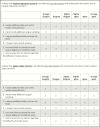Malpractice and Patient Safety Concerns
- PMID: 32651589
- PMCID: PMC7553247
- DOI: 10.1093/ajcp/aqaa088
Malpractice and Patient Safety Concerns
Abstract
Objectives: "Assurance behaviors," a type of defensive medicine, involve physicians' utilization of additional patient services to avoid adverse legal outcomes. We aim to compare the use of clinical behaviors (such as ordering additional tests, services, and consultations) due to malpractice concerns with the same behaviors due to patient safety concerns.
Methods: A national sample of dermatopathologists (n = 160) completed an online survey.
Results: Participants reported using one or more of five clinical behaviors due to concerns about medical malpractice (95%) and patient safety (99%). Self-reported use of clinical behaviors due to malpractice concerns and patient safety concerns was compared, including ordering additional immunohistochemistry/molecular tests (71% vs 90%, respectively, P < .0001), recommending additional surgical sampling (78% vs 91%, P < .0001), requesting additional slides (81% vs 95%, P < .0001), obtaining second reviews (78% vs 91%, P < .0001), and adding caveats into reports regarding lesion difficulty (85% vs 89%, P > .05).
Conclusions: Dermatopathologists use many clinical behaviors both as assurance behaviors and due to patient safety concerns, with a higher proportion reporting patient safety concerns as a motivation for specific behaviors.
Keywords: Assurance behaviors; Defensive medicine; Dermatopathology; Medical malpractice; Melanocytic skin lesions; Patient harm; Patient safety.
© American Society for Clinical Pathology, 2020. All rights reserved. For permissions, please e-mail: journals.permissions@oup.com.
Figures



References
-
- Krader CG. Technical acumen, interpersonal skills influence medicolegal risk. Dermatology Times. 2012. Published September 1, 2012. https://www.dermatologytimes.com/authors/cheryl-guttman-krader/page/1/0 Accessed May 8, 2017.
-
- Troxel DB. An insurer’s perspective on error and loss in pathology. Arch Pathol Lab Med. 2005;129:1234-1236. - PubMed
-
- Troxel DB. Medicolegal aspects of error in pathology. Arch Pathol Lab Med. 2006;130:617-619. - PubMed
-
- Davis GG. Malpractice in pathology: what to do when you are sued. Arch Pathol Lab Med. 2006;130:975-978. - PubMed

